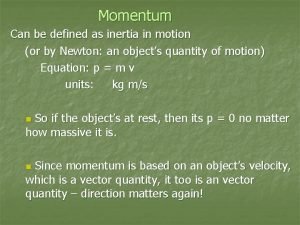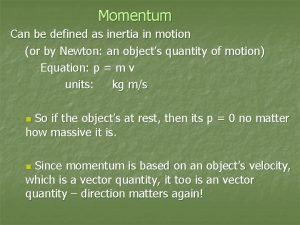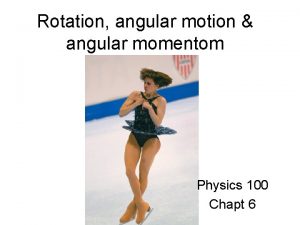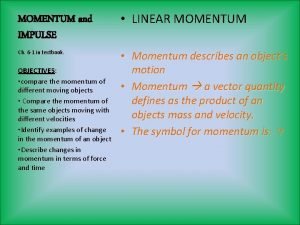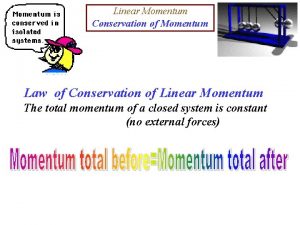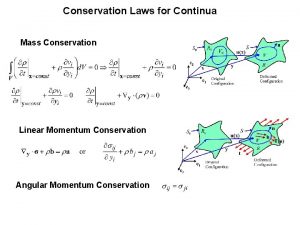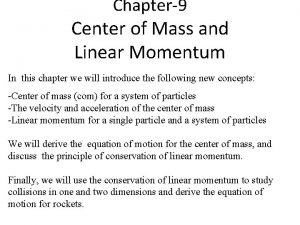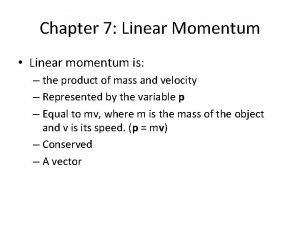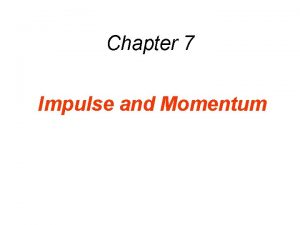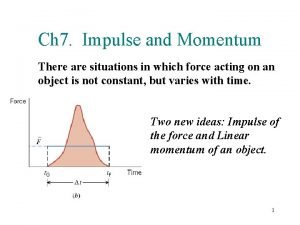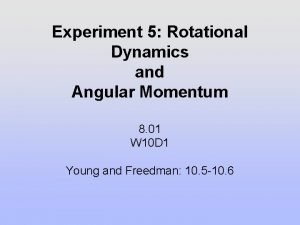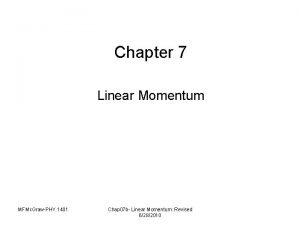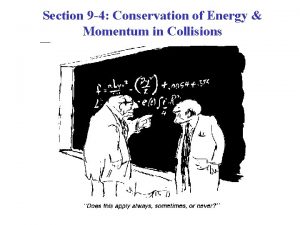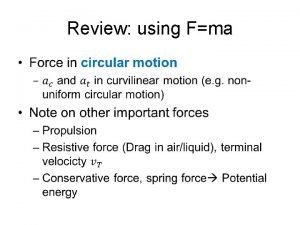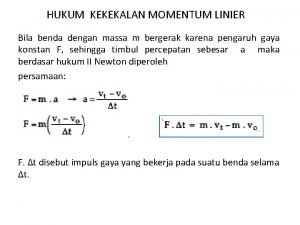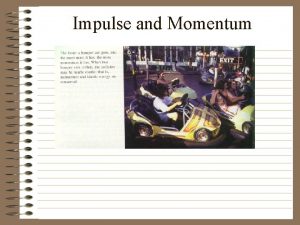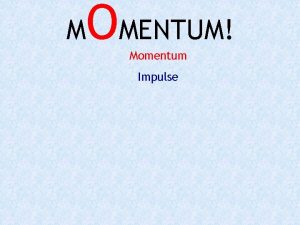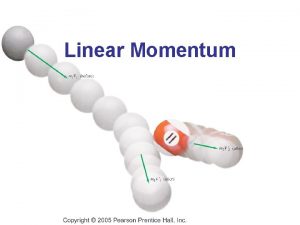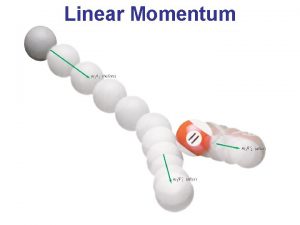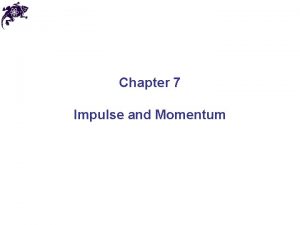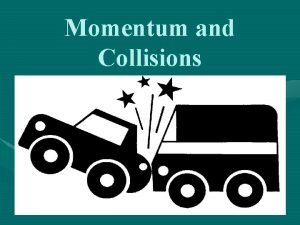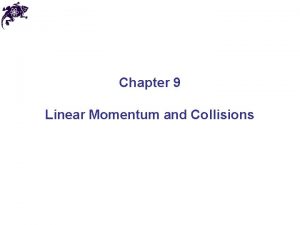Momentum Linear momentum is defined as the product



























- Slides: 27


Momentum -Linear momentum is defined as the product of mass and velocity p=mv where p is momentum -Momentum is a vector! Find the momentum of a car of mass 60 kg travelling at a constant velocity of 20 m/s east. p = 1200 kg m/s east Unit of momentum = kg m/s or N s

Impulse - defined as the product of a force and the time during which it acts - causes a change in momentum J = Fnett = Dp = m. Dv

A force of 1000 N acts on a body of 40 kg initially at rest for a time interval of 0. 05 s. How much impulse is acting on the body? J = 50 N s Unit of impulse is N s which is also a unit for momentum.

Almost every sport involves changing the momentum of something. Therefore every sport involves maximizing impulse. Hitting a ball with as much force as possible increases impulse. What else does? J = Ft Increasing the time the force is in contact with the ball also increases impulse. Contact time = follow through


J = Fnett = Dp = m. Dv

A 100 kg sprinter accelerates from 0 to 8 m/s over a time interval of 6 s. a) What is the sprinter’s change in momentum? b) What is the sprinter’s impulse? c) What is the magnitude of the average force acting on the sprinter? a) 800 kg m/s b) 800 kg m/s c) 133 N

An 80 kg student teacher moves toward the xerox machine but is tackled by Mr. Green. Her speed changes from 2 m/s to 10 m/s in 0. 3 s. a) What is the teacher’s change in momentum? b) What is the impulse acting on the teacher? c) What is the magnitude of the Green force acting on the student teacher?

A 0. 100 kg ball moving at 5 m/s bounces off a vertical wall without a change in its speed. If the collision with the wall lasted for 0. 1 s, what force was exerted on ball by the wall? F = 10 N

The driver of a 240 kg snowmobile accelerates from 6 to 28 m/s over a time interval of 60 s. a) What is the snowmobile’s change in momentum? b) What is the impulse acting on the snowmobile? c) What is the magnitude of the average force acting on the snowmobile? a) 5280 Ns b) J =5280 Ns c) F = 88 N

A 0. 144 kg baseball is pitched horizontally at 38 m/s. After the bat hits the ball, it moves at the same speed but in the opposite direction. a) What is the change in momentum of the ball? b) What was the impulse delivered by the bat? c) If the bat and ball were in contact for 0. 8 milliseconds, what was the average force the bat exerted on the ball? a) 10. 9 kg m/s b) 10. 9 kg m/s c) 13, 680 N

A 5 kg bowling ball is dropped out of a 3 rd floor window (a height of 10 m). It bounces up to a height of 4 m. If the ball is in contact with the ground for 0. 02 s, what average force acts on the ball? 5713 N

Conservation of momentum The total momentum before a collision is equal to the total momentum after a collision. p =p before after 1) Sketch the before and after situation, including all masses and velocities 2) Write the momentums below each object 3) Set total pbefore equal to total pafter

A car of mass 600 kg travelling at 20 m/s collides head on with a truck of mass 2400 kg. If both vehicles come to rest immediately after the crash, what was the velocity of the truck? v = 5 m/s

A 500 kg car is travelling at 15 m/s when it collides with a stationary 100 kg moose. If the car and moose stick together after the collision, how fast are they going?

A 150 kg linebacker is running at 4 m/s toward a 120 kg running back that is running toward him at 6 m/s. If the two collide and momentarily join, what is the velocity of the two players?

A freight train is being assembled in a switching yard. Boxcar #1 has a mass of 6. 5 x 104 kg, and Boxcar #2 has a mass of 9. 2 x 104 kg. If car 1 is moving with a velocity of +0. 80 m/s, and car 2 hits it from behind with a velocity of +1. 2 m/s, with what velocity will the two cars move with together after coupling?

A mass of 3 kg is at rest and a second mass of 5 kg is moving at 4 m/s toward it. Suppose that the smaller mass moves off with a speed of 3 m/s after the collision. What happens to the larger mass? v = 2. 2 m/s

Recoil A 4 kg gun is initially at rest. It fires a 6 g bullet with a speed of 800 m/s. What is the gun’s recoil velocity?

A 2 kg mass and a 4 kg mass are held together with a compressed spring between them. When the spring is released, the 2 kg mass moves away with a speed of 6 m/s. What speed does the 4 kg mass move at?

Test tomorrow – Momentum and Impulse Momentum Dragon buffet Conservation of Momentum

Kinetic Energy – energy of motion - depends on the mass of the object and the speed it is moving at A moving car has kinetic energy. Commonly in a collision, some of this energy is changed into other forms like sound and heat energy.

Energy and Collisions/Explosions Momentum is conserved in all collisions unless an external force is applied Inelastic collision Elastic collision – a collision in which the – a collision in which all total KE decreases KE is conserved - Objects stick together -extremely rare, occur at Explosion (Recoil) the atomic level – the total KE increases as a result of the release of chemical or elastic energy

Page 218 -219 22) 351 kg m/s 23) 4. 8 kg m/s 24) 42 m/s 27) a) 2. 13 x 104 kg m/s b) 313 N 28) a) 2. 3 x 104 kg m/s b) 2. 6 x 104 N 31) a) – 200 kg m/s b) – 4000 N c) 408 kg


A 1325 kg car moving north at 27 m/s collides with a 2165 kg car moving east at 17 m/s. They stick together. In what direction and with what speed do they move after the collision?
 Linear momentum and linear impulse
Linear momentum and linear impulse A collection of well defined objects is called
A collection of well defined objects is called Momentum can be defined as
Momentum can be defined as Momentum can be defined as
Momentum can be defined as Multiplying and dividing matrices
Multiplying and dividing matrices Chapter 6 momentum changing momentum
Chapter 6 momentum changing momentum L
L Angular quantities
Angular quantities Linear impulse momentum equation
Linear impulse momentum equation A 2250 kg car traveling to the west slows down
A 2250 kg car traveling to the west slows down Law of conservation of linear momentum
Law of conservation of linear momentum Conservation of linear momentum
Conservation of linear momentum Center of mass and linear momentum
Center of mass and linear momentum Perfectly elastic collision
Perfectly elastic collision Linear momentum
Linear momentum Kekekalan momentum linear
Kekekalan momentum linear Calculate the impulse experienced when a 70kg person
Calculate the impulse experienced when a 70kg person Conservation of linear momentum
Conservation of linear momentum Conservation of linear momentum
Conservation of linear momentum How to find change in momentum
How to find change in momentum Angular momentum of disc
Angular momentum of disc Elastic momentum
Elastic momentum Law of conservation of momentum
Law of conservation of momentum Average linear momentum
Average linear momentum Momentum linear adalah
Momentum linear adalah When is momentum conserved
When is momentum conserved Rumus momentum
Rumus momentum Hình ảnh bộ gõ cơ thể búng tay
Hình ảnh bộ gõ cơ thể búng tay


